NCERT Notes for Class 10 Science Chapter 9 Heredity And Evolution
CBSE Class 10 Science notes will assist students in studying the topic thoroughly and clearly.
These CBSE Class 10 Science notes were written by subject experts who made the study material very basic, both in terms of language and format.
Heredity, Mendel’s Contribution
Inheritance or heredity refers to the passing or transfer of characteristics (from parents to children). The process through which features and characteristics are passed down from generation to generation is referred to as heredity. However, not all of the traits of progeny are identical to their parents.
The principles of heredity dictate how qualities are inherited. They exhibit a range of traits. Thus, variations refer to the distinctions between the characteristics (traits) of individuals within a species. Character inheritance may occur during asexual or sexual reproduction.
Accumulation of Variations During Reproduction
Inheritance from the past gives the following generation both a similar body design and subtle alterations to it. When the new generation reproduces, the second generation will inherit both inherited and newly developed distinctions.
For instance, if a bacterium splits and produces two persons, each of those people will divide again and produce two further individuals in the following generation.
The four individual bacteria formed would be remarkably identical but for tiny variances caused by modest errors in DNA copying.
However, sexual reproduction generates considerably more variability. Various people would have different benefits depending on the nature of the differences, for example, bacteria that can endure heat would live better during a heat wave.
Inheritance of Traits
Genes regulate the traits or qualities that are handed down from parents to their children generation after generation.
A portion of DNA that contains information about a particular protein is referred to as a gene for that protein. Due to genetic variances, human populations exhibit a considerable lot of variety in the expression of different features, such as height, skin tone, eye colour, nose, lip, and ear shape, and blood type.
Attached and free earlobes have been documented in human cultures. The earlobe is the lowest portion of the ear. The earlobe is not linked to the side of the head in free earlobes. Whereas with an attached earlobe, the earlobe is tightly linked to the head’s side. This unique characteristic is inherited.
Mendel’s Contribution towards the Inheritance of Traits
- The laws governing the inheritance of features in humans are based on the fact that both parents contribute an equal quantity of genetic material to the kid.
- This indicates that both father and maternal DNA may have an effect on each attribute. Thus, each feature will have two manifestations in the child. Mendel established the fundamental laws governing such inheritances.
- In the majority of living creatures, heredity is governed by well-defined rules. Mendel conducted his studies on garden peas (Pisum sativum). His trials with garden pea, together with the conclusions he drew, laid the groundwork for contemporary genetics.
- Mendel’s efforts were singular in their application of diverse variables and mathematics to the issue. He maintained a separate record for each generation and focused on the inheritance of a single pair of characters at a time.
Inheritance of Traits for One Contrasting Character
- Mendel selected pea plants with varying physical features, including height (short and tall plants).
- All of their descendants (F1- generation plants) were tall. Mendel then permitted self-pollination of F1 progeny plants.
- He discovered that none of the plants in the F2- generation were tall; three-quarters of them were tall, and one-quarter were small. This finding suggested that both low stature and tall stature were inherited in the F1- generation. However, in the F1- generation, only the tallness trait was exhibited.
- Each sexually reproducing creature inherits two copies of the features.
- TT and Tt are tall plants phenotypically, but tt is a small plant. A single copy of ‘T’ is sufficient for a plant to grow tall. Thus, in characteristics Tt, ‘T’ represents a dominant trait, while ‘t’ represents a recessive feature. Both characters are restored in F2- generation, despite the fact that one of them is absent from the F1 stage. During gamete production, a pair’s factor or alleles segregate.
Inheritance of Traits for Two Visible Contrasting Characters
- Mendel selected two distinct pea plants, one with a green spherical seed and the other with a yellow wrinkled seed.
- When the F1 progeny were obtained, they had round and yellow seeds, demonstrating that round and yellow are dominant features.
- Mendel then permitted self-crossing (self-pollination) of the F1 offspring in order to create F2 progeny. He discovered that seeds came in a variety of shapes and colours, including round yellow, round green, wrinkled yellow, and wrinkled green.
- The ratio of plants with the aforementioned characteristics was 9: 3: 3: 1. (Mendel observed that two new combinations had appeared in F2).
- During F2- generation, each of the four characters was randomly assigned. As a result, he asserted that an alternating or contrasting pair of characters acts independently of the other pair. For instance, seed colour is unrelated to seed coat.
Expression of Traits
- DNA is the source of information for the cell’s protein synthesis. A portion of DNA that contains information about a specific protein is referred to as a gene for that protein.
- As we all are aware, plants contain hormones that stimulate growth. As a result, the quantity of plant hormone produced dictates the plant’s height. And the quantity of plant hormone produced is dependent on the efficiency of the manufacturing process.
Evolution
Evolution, or organic evolution, is the process through which basic living forms gradually evolve into sophisticated life forms. Because evolution incorporates living beings, it is referred to as organic evolution.
Variations in a Population
Variation is the term used to describe the changes in phenotype and genotype, the individuals within a population, or between parents and their children. Assume twelve red beetles dwell in green-leaved plants. Their population expands by sexual reproduction, resulting in variety. Variation in a population of beetles may arise in the following ways.
Situation I – A colour difference may occur during reproduction, resulting in the generation of a green beetle. It imparts the colour green to its offspring. Crows are unable to consume green-colored bugs on green foliage because they cannot see them.
As a result, the grey beetles continue to be consumed, while the population of green beetles expands. Variation confers a survival benefit in this example. Crows’ natural selection will ensure the survival of green beetles.
Situation II – In another scenario, a colour change occurring during reproduction may result in a blue beetle rather than a grey beetle, and all of its descendants will be blue.
- Crows are capable of seeing both blue and grey-colored insects and hence may consume chem. At first glance, there are a few blue beetles and a greater number of grey beetles.
- Suddenly, an elephant scurries through the bushes, annihilating the majority of the bugs. By accident, the few beetles that survived were mostly blue, and their numbers eventually increased. Genetic drift is the gradual increase in the frequency of certain genes in a population that results in variety without a survival penalty.
Situation III – Here, the bushes get a plant disease, and the quantity of leaf material available to the beetles has decreased as a result of the bugs’ population increase. As a consequence, the beetles are malnourished, and their average weight has plummeted.
After a few years, the plant disease should be eradicated, leaving plenty of food for the beatles. They will then revert to their regular weight. There is no genetic change happening in this instance. Thus, only phenotypic variation between identical genotyped organisms is possible.
Acquired and Inherited Traits
The features gained by a person throughout his or her lifetime that cannot be passed on to his or her descendants are referred to as acquired traits (characters). Individuals’ lifetime experiences cannot be passed on to their descendants and cannot be used to drive development.
For instance, if we breed a colony of mice and surgically remove their tails, the descendants will not be tailless. This is because removing the tail has no effect on the genes of the mice’s germ cells and so has no effect on evolution.
Thus, it demonstrates that changes in non-reproductive organs cannot be transferred to the germ cell DNA. Inherited qualities are those features that kids inherit from their parents (i.e. from one generation to the next, such as hair and eye colour, nose and earlobe form, etc.)
Origin of Life on Earth
Darwin’s evolutionary theory explains how life developed from simpler to more complex forms. Mendel’s experiments establish the process through which characteristics are passed down from generation to generation.
However, none of these explains how life arose on Earth in the first place. In 1929, British scientist, biochemist, and geneticist JBS Haldane suggested that life must have evolved from basic inorganic components.
These molecules may have evolved on the Earth via a lengthy succession of physiochemical changes that resulted in increasingly complex organic compounds. Organic evolution is the progressive change or development of complex forms from simpler ones.
In 1953, Stanley L Miller and Harold C Urey provided experimental evidence for Haldane’s idea of life’s beginning.
They constructed an atmosphere over water in an airtight device comparable to that which existed on early Earth (containing ammonia, hydrogen, methane, water vapour, and hydrogen sulphide, but no oxygen). This was kept at a temperature of about 100°C. To trigger lighting, continuous sparks were sent through the combination of gases.
After a week, 15% of the carbon in CH4 had been transformed to simple carbon molecules such as amino acids (making up the protein molecule).
Speciation
It is the process through which one or more species evolve from another. It happens when two populations are physically and reproductively separated, resulting in essentially little gene flow between them.
However, interbreeding continues within isolated groups, resulting in an increasing number of generations. Eventually, even if they have a chance to meet, the members of these two groupings will be incapable of reproducing with one another.
Genetic drift accumulates a variety of alterations in a subpopulation across generations. Additionally, natural selection may function differently in these various geographic regions.
For example, crows may be wiped out by eagles within the region of one subpopulation. However, this may not be the case in the other subpopulations, where crow populations will likely increase significantly.
As a result, the green version will not be chosen at the first location. While the second will be quite selective. When genetic drift and natural selection act in concert, two isolated subpopulations may become more distinct from one another. This will result in the emergence of new species. These novel species might have evolved.
(i) if the DNA modifications are significant enough, such as a change in the number of chromosomes, the two groups’ germ cells will ultimately be unable to unite.
(ii) if a new variant occurs in which females may mate with a limited number of men owing to their unique characteristics. This enables a high degree of natural selection for that attribute.
Evolution and Classification
Evolution is the process through which newer forms of organisms evolve from pre-existing ones as a result of alteration caused by external influences such as environmental change.
Characteristics are the specific aspects of an object’s appearance or behaviour, in other words, a particular shape or function. For example, human beings’ forelimbs are a trait, as is the ability of plants to accomplish photosynthesis.
Classification is the process of grouping organisms according to their physiological, biochemical, anatomical, or other characteristics. All categorization systems are hierarchical.
Hierarchy is a social organisation style in which people are ranked according to their position or dominance in comparison to other group members.
Basic Characteristics of an Organism
- In all living species, the cell is the fundamental unit of life.
- Certain species’ cells lack an organised nucleus, for example, the bacterial cell. Whereas some other creatures’ cells include a well-organized nucleus.
- Some creatures with a fully formed nucleus are unicellular, whereas others are multicellular.
- Similarly, certain multicellular creatures can synthesise their own food (photosynthesis), whereas others cannot.
- Another distinction between unicellular and multicellular creatures is that certain multicellular organisms have a skeleton embedded inside their bodies, whilst others have a skeleton wrapped around their bodies.
Evolutionary Relationships with Classification
- The more closely related two species are, the more features they will share. And the closer they are linked, the more recent their shared ancestors were. Allow me to illustrate this principle using the following example:
- A sister and a brother are inextricably linked since they share an ancestor in the preceding generation, namely their parents.
- A first cousin and a girl are distant cousins, but not as distant as her brother. The cousins have a common ancestry, namely their second generation grandparents. Thus, the taxonomy of organisms reveals evolutionary links.
Tracing Evolutionary Relationships
- To ascertain the evolutionary links of species, it is necessary to examine their shared characteristics.
- These shared characteristics across creatures indicate a common ancestor. Numerous disciplines have supplied evidence, as listed below:
Homologous Organs
- Darwin hypothesised that more closely related species originated from a common ancestor.
- The shared traits and essentially comparable anatomy, such as the forelimbs of vertebrates, support the likelihood of a common ancestor.
- The phenomenon of structural resemblance owing to shared ancestry is referred to as homology.
- The characteristics of the homologous organ are as follows
- Have the same fundamental structure and developmental origin.
- Perform distinct roles in various species.
- Their resemblance is attributable to shared ancestors. For example, the forelimbs of vertebrates (lizard, man, frog, and bird) are structurally identical yet have distinct purposes.
Analogous Organs
- Organs that have a distinct origin and fundamental structure (plan), but have a similar appearance and function, for example, the wings of birds and bats.
- The following characteristics of similar organs are listed:
- Differ in their fundamental structure.
- Share functional similarities.
- Their similarity is superficial. For example, the wings of bats and birds are structurally and morphologically distinct yet perform the same function of flight.
Fossils
- These are the fossilised remains of living organisms from millions of years ago. It is not usually required to see how each component of a decomposing organism decomposes. For instance, a dead bug entangled in heated mud.
- The mud inhibits the insect’s decomposition. Rather than that, the mud will ultimately solidify and preserve the imprint of the insect’s bodily components. This gives proof of the insect’s existence and also informs us about the insect’s structure.
- Archaeopteryx fossils are the connection between reptiles and birds. This is because it has feathered wings and a beak similar to those of birds, but reptile-like teeth and a tail. Thus, it is believed that chat birds developed from reptiles.
Dating of Fossils
- If we were to excavate the ground and discover fossils, the deepest levels would often include the earliest fossils, as opposed to the superficial layers.
- Another technique for dating fossils is to determine the ratios of several isotopes of the same element included in the fossil material.
Fossil Formation (Fossilisation)
Fossils are created in layers. It is a lengthy procedure that is entirely reliant on the location of the organism’s death. By and large, fossils are generated from the organism’s hard components, such as tree trunks or the skull.
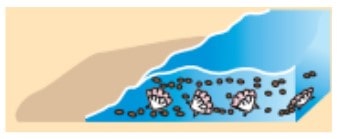 | Some creatures died on the seafloor and were buried in the sand around 100 million years ago. More sand collected over time, and sand-stones developed under pressure. |
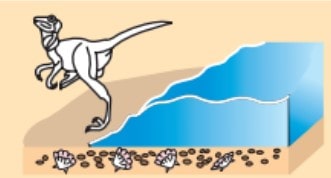 | The dinosaurs died in the region and were buried in the mud millions of years later. |
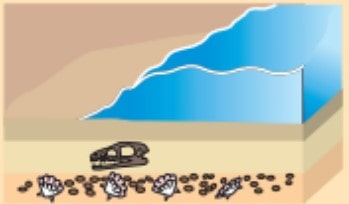 | The mud was also crushed into rocks, on top of a previous structure bearing earlier invertebrate fossils. |
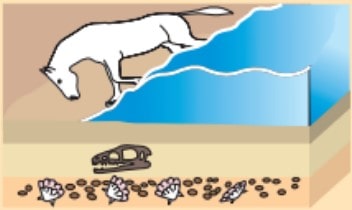 | Horse-like creatures’ corpses were also fossilised in layers above the rocks holding dinosaur fossils millions of years later. |
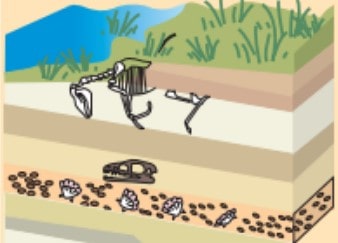 | Water later flowed and uncovered the horse-like fossils as a result of erosion. Older fossils may be discovered by digging deeper. |
Evolution by Stages
Complex organs, such as the eyes, are not chosen by a single DNA mutation. Such intricate organs are developed gradually over generations and seem to be a critical adaptation. Even an intermediate stage, such as basic vision, might be beneficial to a degree.
This structure varies across creatures and is sufficient to imply distinct evolutionary origins. Additionally, there are certain improvements that are beneficial for the co-start of one property.
However, they finally become valuable for a completely different purpose. Feathers, for example, originated to give insulation in cold temperatures, but lacers were designed to let animals such as birds to fly.
Indeed, some dinosaurs have feathers, yet they lacked the ability to fly using flight. Thus, we may deduce that birds and reptiles are extremely closely linked, since dinosaurs were reptiles.
Occasionally, structures with diverse appearances originated from shared forebears. Thus, through researching fossils, evolutionary relationships may be identified.
One contemporary example of this kind of evolutionary interaction is the wild cabbage plant. For almost two thousand years, humans have farmed wild cabbage as a food plant and have evolved many vegetables from it via selection.
This is not natural selection, but artificial selection (i.e. man-made species alteration by selective breeding). Broccoli, Red cabbage, Cauliflower, kohlrabi, and kale are all descended from the same progenitor, which was wild cabbage.
The study of evolutionary connections is predicated on the premise that changes in DNA during reproduction are fundamental evolutionary processes. This is a widely utilised technique in the modern day.
It establishes the evolutionary link between species by comparing their DNA and providing a direct estimate of how much DNA has altered throughout species creation.
Evolution versus Progress
The term “evolution” should not be used interchangeably with “progress.” There has been no significant advancement in the idea of evolution. It is just the process by which natural selection generates variety and environmental selection shapes it.
The concept of evolution does not imply that the animals and plants we observe around us originated from one another or that one species evolved at the expense of another.
Everything will be determined by the environment. It is simply that natural selection and genetic drift have combined to create a population that is incapable of reproducing with the original.
Indeed, several species have comparable characteristics as a result of their evolution from a common ancestor. Consider the situation of humans and chimps. It is untrue that humans developed from chimps.
Rather than that, humans and chimps have a greater degree of similarity than the other ape species, indicating that they share a more recent ancestor or common ancestor.
The graphic below demonstrates the possible evolution of humans and apes from a shared ancestor.
While increasingly complicated body shapes have evolved throughout time, this does not indicate that earlier and simpler living forms were inefficient.
Numerous of these life forms continue to exist, for example, bacteria, the simplest form of life, can live under adverse environmental circumstances (like deep sea thermal vents, hot springs and the ice in Antarctica).
Human Evolution
There is a tremendous deal of variation in human shapes and characteristics around the world. The techniques for tracing evolutionary links have been used in the study of human evolution.
For instance, excavation, time dating, fossil studies, and deciphering DNA sequences. Due to the diversity of human shapes and characteristics, skin colour was historically the most popular technique to distinguish races.
However, the movement of human races does not have a biological foundation. All people are members of the same species. Homo sapiens, the first member of the human species, originated in Africa.
- A few hundred thousand years ago, some of our forefathers and mothers departed Africa, while others remained.
- Residents moved over Africa, while migrants migrated to West Asia, Central Asia, Eurasia, South Asia, East Asia, Indonesia, the Philippines, Australia, and America.
- They did not travel in a straight path, indicating that they were not visiting various locations only for the sake of travel.
- Rather than that, they moved ahead and backward, with the group parting at times and reuniting at others.
- Like all other species on the planet, they had evolved by chance. They were likewise attempting to live their lives to the fullest.